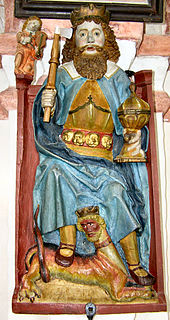Beard (heraldry)
Barte (etymologically related to halberd and key beard ) is the heraldic collective term for hatchets and axes that have found their way into heraldry as a heraldic figure . The adze (the cross hatchet) also appears as a heraldic figure, but is not one of the beards. The beard has a variety of names in heraldry, which only partly follow the usages of weapons technology or tool knowledge. It is sometimes generally referred to as a battle ax or battle hatchet , although mostly not a weapon but a tool is depicted, as is the case with the coat of arms of Ried in der Riedmark .
Representation and symbolism
Either a historical weapon of war is depicted, but more often a local tradition of forestry or woodworking . Local and temporal designs can be read in the representations.
The ax is the guild insignia of foresters (formerly known as lumberjacks ) and carpenters . The beard as a sign of the order usually also means the tool used for non-warfare work, as can be seen, for example, in the Aragonese order of the ladies of the ax since 1448 . In contrast, the coat of arms of Tobor, which is considered to be one of the oldest Polish coats of arms and is said to have been the first coat of arms of the Polish knighthood, shows a battle ax .
If two beards are shown combined on a coat of arms, the owner of the coat of arms indicates that he has mastered both warlike and peaceful activities.
Blazon
The beard is mostly emblazoned in natural colors (leaf and stem) or monochrome. It is not only present in the coat of arms , but also as a helmet ornament in the upper coat of arms . As with all long guns / stick tools, diagonally crossed with a second device is also common.
use

The beard is a common figure with worldwide distribution. States like Kenya and Belize use the beards for their coats of arms; In Norway , the national coat of arms shows a lion holding a beard, and the beard is the attribute of the national saint, Olav .
Municipalities and noble houses also use the beard; the south-west German aristocratic family of Sturmfeder von Oppenweiler even got its name after the weapon, its coat of arms shows two storm springs turned to the right and left.
A silver carpenter's ax in blue : Frauenzimmern ( speaking )
In mixed up colors : Beilngries , old coat of arms (speaking)
Applied to the binding shield in mixed up colors : Hacking / Vienna (talking)
Coat of arms of the former town of Bartenstein (Schrozberg) : In blue on a floating golden three mountain, two upright, turned away, silver beards (speaking)
- as an addition
A lion with an ax in its paw: the national coat of arms of Norway
Ax in an archer's belt: Lieksa , Finland
- combined
overturned in Göpelschnitt : Bindersbach
- crossed
Biel / Bienne , Switzerland
Raftershook and ax (Austrian hoe ): Palfau , Austria
Coat of arms of the Polish city of Bartenstein ( East Prussia )
literature
- Johann Georg Krünitz : Economic Encyclopedia . Verlag Joachim Pauli, Berlin 1773, p. 551 ( Digitized version of the encyclopedia. University of Trier).
- Roßberg (Hrsg.): Latest ladies conversation lexicon . Verlag der Roßberg'schen Buchhandlung, Leipzig 1856.
- Hermann Weiß: Costume studies: history of costume and equipment in the Middle Ages from the 4th to the 14th century . Verlag Ebner & Seubert, Stuttgart 1864, p. 722 .













